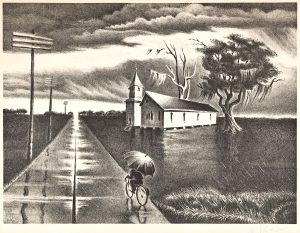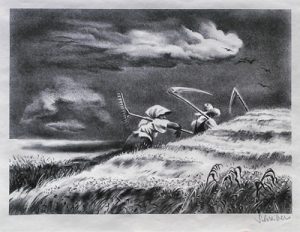THE LIFE & LEGACY OF ARTIST GEORGES SCHREIBER (1904-1977)
By Victoria Chick, Figurative Artist and Early 19th & 20th Century Print Collector
Although not well known today, Georges Schreiber was a successful painter and printmaker during the 1930s and 40s. He was born in Brussels, Belgium in 1904 to German parents, attended a German Gymnasium in Brussels for his early education, and, later, studied at an Arts and Crafts School in Germany and at Academies of Fine Art in Berlin and Dusseldorf. He was well-trained.
He was 10 and living in Brussels when WWI broke out. The Belgian children gave him a difficult time because he was German. When his family returned to Germany, he was 14 and the German children gave him a hard time for “missing” the war. All of Europe had been affected adversely during WWI but life in Germany after the war was particularly hard in the 1920s since Germany was the loser in the conflict. Food was very scarce, as were other household products. During his late teens and early twenties, he did drawings and cartoons for German newspapers and periodicals in addition to the private fine art he did in his studio.
Schreiber emigrated from Germany to the United States in 1928, supporting himself at first by selling drawings and cartoons to newspapers in New York. This quick work gave him time to set up his studio, continue his serious art, and find dealers to represent him. His resolve to work hard to pursue his art goals was continuously thwarted by the Great Depression between 1928 and 1938 but his personality had been formed in adverse times and he was able to overcome adversity by always being ready to take advantage of passing opportunity.

He was attracted to American Scene painting and Regionalist ideas of what the content of American painting should be. “I don’t want to be just an American with citizenship papers”, he said. “I want to completely associate myself with America”. Toward this end, Schreiber made six trips across the United States between 1936 and 1939, observing the daily life of Americans in every state, and portraying their work and leisure in painting and in lithography. He was especially empathetic to those leading hard physical lives and depicted them in a heroic manner. An exhibition of his paintings, “Panorama of America”, based on his trips, and shown at the Gallery of Associated American Artists in New York was reputedly so successful, that all the paintings were sold before the exhibition opening. In researching this exhibition most of the illustrations are of lithographs, some in color. It may be paintings sold so quickly they were removed prior to being photographed. Now doing very well financially, he purchased a summer home in Martha’s Vineyard, where many artists lived. He became great friends with his neighbor, artist Thomas Hart Benton.
Schreiber and Benton worked together during WWII for the Navy on an art project depicting life aboard a submarine, Schreiber also worked for the Army as an artist and designed posters encouraging people to purchase War Bonds. Schreiber is often compared to Benton and did work in a similar manner at times. but Schreiber also adopted a surrealist style, particularly when doing musical and circus themes.

His art periodically led him back to illustration. When Bruno Hauptmann was on trial for kidnapping Charles and Anne Lindbergh’s baby, Georges Schreiber was the courtroom artist. His sketches of that trial can be seen in many documentary films. He continued to do cartoons and sketches for newspapers; he illustrated the books, “Little Man What Now”, and “Portraits and Self-Portraits,” and contributed work to “Life” and “Fortune” magazines.
Schreiber preferred rural to urban subjects. His compositions frequently depicted human figures against simple landscape backgrounds. He tried to understand the people he drew. “I want to live these people…..not depict them”, he said.
His work is in the Metropolitan Museum of Art, Whitney Museum of American Art, Brooklyn Museum, L.A. County Museum of Art, Bibliotheque Nationale, Museum of Tel Aviv, Springfield Museum, Newark Museum of Art, and others.
In 1958, Schreiber joined the faculty of the New School for Social Research in New York, and in 1964 he was artist-in-residence at Northern Michigan University in Marquette.
Schreiber died in New York in 1977. A memorial exhibition was held at Kennedy Galleries, his dealer since 1970. In 1994, D. Wigmore Fine Art became the exclusive dealer for the Schreiber Estate.
Victoria Chick is the founder of the Cow Trail Art Studio in southwest New Mexico. She received a B.A. in Art from the University of Missouri at Kansas City and awarded an M.F.A. in Painting from Kent State University in Ohio. Visit her website at www.ArtistVictoriaChick.com


